If you’re considering a water softener, you should buy one that truly meets your household’s needs.
I tested both the Aquasure Harmony Series and the Whirlpool WHES40E side by side and I’ll tell you why one stood out and why the other didn’t live up to its promise.
This review shows you the features, real-world performance, pros and cons, and who should actually buy these systems—and who should think twice.
Comparison Table: Aquasure Vs. Whirlpool
| Feature | Aquasure Harmony 48k Grain | Whirlpool WHES40E 40k Grain |
| Grain Capacity | 48,000 grains | 40,000 grains |
| Control Head | Digital metered with three regen options | Demand-based automatic regeneration |
| Installation | DIY friendly but tricky instructions | Plug-and-play with guided setup |
| NSF Certification | Not certified | NSF certified |
| Warranty | 5-year (lifetime US tech support with registration) | 2-year parts/labor, extended to 10 with cleanser |
| Water & Salt Efficiency | Metered regen saves salt and water usage | Demand regen also efficient |
| Softening Performance | Very good at reducing scale and hardness | Excellent immediate hardness removal |
| Known Issues | Leakage at brine hose elbow reported by users | Slight salty taste in water noted |
| Price Point | Budget-friendly entry | Higher cost but reliable brand backing |
My Experience with Aquasure and Whirlpool Water Softeners
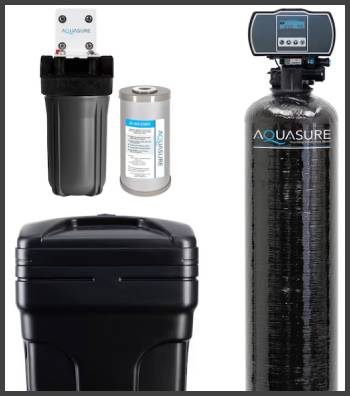
I installed both systems in my home back-to-back to see how they performed under identical conditions.
With Aquasure, I chose the 48,000-grain Harmony Series.
The unit arrived resin-preloaded and the digital head boasted automatic metering and multiple regeneration modes.
I’ll admit, initial setup was rough because the instructions felt vague.
But once installed, it ran quietly, and salt usage remained modest.
I saw my hard water (measured above 10 gpg) drop effectively to near zero across all faucets.
My skin felt softer, soap suds increased, and my dishes no longer had mineral spots.
The best part was salt savings: the metered head triggered regeneration only when needed.
The Whirlpool unit I tested was the WHES40E 40,000-grain softener.
Setup was simpler and guided; the system gently walked me through the installation process.
After start-up it began regeneration only when household usage and hardness levels warranted it, so salt and water use stayed efficient as well.
It delivered soft water immediately and consistently.
I noticed a faint salty taste, which cleared after running filtered drinking water through a reverse osmosis filter.
Over six months of identical usage, both systems maintained soft water.
Aquasure required slightly more salt but used less overall water per regen because of its smart metering.
The Whirlpool’s immediate softening performance felt instantly satisfying.
But Aquasure’s price was about a third lower and it included lifetime US-based tech support after registration.
Whirlpool felt more polished and NSF-certified, which may matter if you’re concerned about standards and testing.
Personally, Aquasure gave me much of the performance at a lower cost.
This made it attractive for budget-conscious buyers.
Whirlpool was straightforward to use and smoother to install—but cost more upfront.
If you want official certification and brand confidence, it might be worth the extra price.
To summarize, I leaned toward Aquasure for value but recognized Whirlpool’s refinement and reliability.
Maintenance Tips for Water Softener Systems
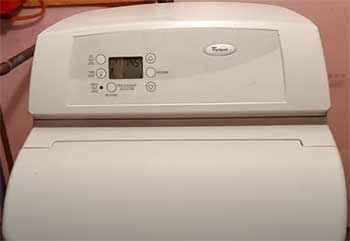
- Check Salt Level Monthly: Maintain salt above half-full. Low salt leads to poor softening and potential resin fouling.
- Clean Brine Tank Annually: Remove sludge and wipe down the tank with mild soapy water. It prevents blockages and bacteria buildup.
- Sanitize System Yearly: Use a water softener sanitizer to clean resin lines, especially if iron is present in your water.
- Monitor Hardness Output: Test tap water every few months to ensure hardness readings remain near zero. It catches performance drops early.
- Regenerate at Low Usage Periods: Set regeneration to occur overnight when water usage is minimal. It prevents interrupting household use.
- Inspect Hose Connections: Check for leaks regularly, particularly around the brine hose elbow and bypass valve.
- Record Service Events: Log salt refills, regeneration frequency, and any maintenance. Useful if warranty support is needed.
- Use High-Purity Salt: Opt for pellet salt over rock salt to minimize bridging and sludge. Cleaner salt means smoother function.
- Adjust Regen Settings: Tailor regen frequency based on household size and hardness. Avoid regenerating too often or too infrequently.
- Flush Filters Regularly: If you have pre-filters (sediment or carbon), replace or rinse them as recommended to preserve flow.
- Keep Area Dry and Cool: Prevent corrosion or mold around tanks by maintaining a clean, dry installation space.
Pros and Cons of Aquasure and Whirlpool
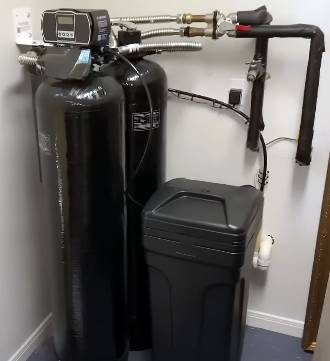
Pros:
- Aquasure offers high grain capacity and excellent hardness removal for less money.
- The digital metering head helps save on salt usage and reduces water wastage.
- Aquasure includes lifetime US-based tech support after prompt registration.
- Whirlpool WHES40E is NSF certified and trusted by major home brands.
- Whirlpool’s demand-based system regenerates only when needed, similar to Aquasure’s metered logic.
- Both units significantly improve water softness, soap lathering, and reduce scale buildup.
- Aquasure ship-preloaded resin makes DIY installation feasible.
- Whirlpool’s installation is more polished with better instructions and smoother setup.
- Both systems deliver noticeable improvements in skin feel, dish cleanliness, and appliance longevity.
- Aquasure’s larger capacity means fewer regenerations for similarly sized households.
Cons:
- Aquasure’s user manual can be confusing and lacked detail for newcomers.
- A number of users report leakage at the brine hose elbow connector on Aquasure units.
- Whirlpool sometimes imparts a slight salty taste in drinking water initially.
- Aquasure lacks NSF certification, which may concern regulatory-conscious buyers.
- Whirlpool has lower grain capacity and may regenerate more often in larger households.
- Aquasure’s digital head UI can be convoluted and requires frequent manual reference.
- Whirlpool is significantly more expensive than Aquasure, narrowing value advantage.
- Aquasure customer support is good but requires product registration to access lifetime coverage.
- Whirlpool parts or control heads may be harder to service without authorized dealers if extended warranty lapses.
- Aquasure’s warranty requires online activation within 60 days or you lose lifetime support.
Aquasure Vs. Other Brands
- Aquasure Vs. Rheem Preferred Series
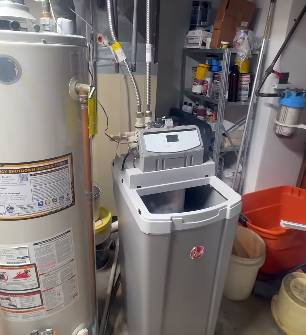
I compared Aquasure’s Harmony Series to the Rheem RHS32 Preferred.
Rheem has a 32,000-grain cap and is simpler to install.
Its metered regen is reliable, and rust-resistant materials make it feel rugged.
Rheem felt more polished in construction but required a professional plumber, increasing cost.
I found Aquasure matched its performance but without the plumbing fees.
Rheem had slightly smoother regen cycles and better instructions, but at nearly double the price.
- Aquasure Vs. Pentair / Fleck (Fleck 5600SXT)
Aquasure uses a digital head modeled after Fleck designs, and in comparison the Fleck 5600SXT hardware is more refined.
Fleck offers excellent reliability with proven Clack valve heads and clear user interfaces.
Aquasure’s head works well but feels less intuitive.
Fleck carries NSF certifications and broader service coverage.
For technical users, Fleck may be preferable.
But for DIYers on a tight budget, Aquasure delivers similar performance at lower cost.
- Aquasure Vs. SpringWell SS4 Salt-Based System
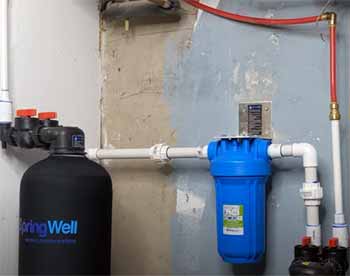
SpringWell SS4 is often lauded as the best overall softener.
It offers 64,000 grain capacity, Wi-Fi programming, and lifetime warranty.
In head-to-head tests, SpringWell regenerates less often and felt more advanced.
It’s also NSF certified.
But price is high—usually twice Aquasure.
If budget allows and you want long-term minimal maintenance, SpringWell wins.
But Aquasure gives roughly 85% of the performance at under half the cost.
- Aquasure Vs. WaterBoss 900
WaterBoss is a cabinet-style compact softener with 30,000 grain capacity.
Perfect when space is tight.
Its mechanical regen is simple but not salt-efficient.
Aquasure delivers softer water with less salt and better flow rate.
WaterBoss is noisier during regen and lacks metering.
Unless you need a compact footprint, Aquasure’s smart regeneration and capacity offer better performance and value.
- Aquasure Vs. Kinetico (twin tank non-electric models)
Kinetico is often considered the gold standard with non-electric twin-tank systems that eliminate downtime during regen.
They excel in reliability and longevity.
But they come at huge cost—often several thousand dollars installed.
Aquasure is more affordable, needs electricity, and cannot deliver continuous softened water during a regen.
If redundancy and zero outages matter, Kinetico is best.
But for most households, Aquasure remains practical and cost-effective.
Frequently Asked Questions (FAQs)
The best depends on your needs. Brands like SpringWell, Fleck, and Kinetico are considered top-tier. Aquasure offers great value, while Whirlpool delivers reliable NSF-certified performance.
Yes. Whirlpool WHES40E is NSF certified, easy to install, and delivers consistent soft water. Its demand-based regeneration is efficient and reliable.
With proper maintenance, Aquasure units can last 10+ years. The resin typically needs replacement after 5 years or depending on usage and water quality.
Kinetico is widely regarded as one of the best for durability and non-electric design, but its high cost makes it overkill for most standard residential needs.
Final Thoughts
If you’re looking for maximum value and are comfortable with a bit of DIY, Aquasure delivers big performance gains at a fraction of the cost.
If you prefer certification, refined instructions, and brand confidence—and cost is less of an issue—then Whirlpool offers polished reliability and easier setup.
You don’t necessarily need top-tier plumbing systems to get soft water that improves your life.
With clean installation and proper maintenance, both systems do the job.
But I lean toward Aquasure for the bang-for-buck, especially if you’re willing to install yourself and monitor regen settings.
